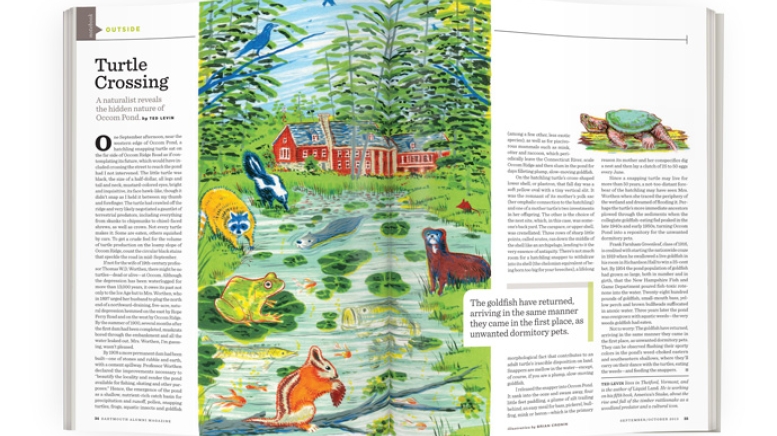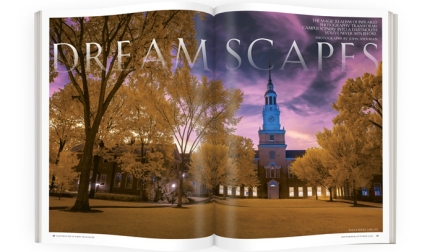One September afternoon, near the western edge of Occom Pond, a hatchling snapping turtle sat on the far side of Occom Ridge Road as if contemplating its future, which would have included crossing the street to reach the pond had I not intervened. The little turtle was black, the size of a half-dollar, all legs and tail and neck, mustard-colored eyes, bright and inquisitive, its face hawk-like, though it didn’t snap as I held it between my thumb and forefinger. The turtle had crawled off the ridge and very likely negotiated a gauntlet of terrestrial predators, including everything from skunks to chipmunks to chisel-faced shrews, as well as crows. Not every turtle makes it: Some are eaten, others squished by cars. To get a crude feel for the volume of turtle production on the loamy slope of Occom Ridge, count the circular black stains that speckle the road in mid-September.
If not for the wife of 19th-century professor Thomas W.D. Worthen, there might be no turtles—dead or alive—at Occom. Although the depression has been waterlogged for more than 13,000 years, it owes its past not only to the Ice Age but to Mrs. Worthen, who in 1897 urged her husband to plug the north end of a northward-draining, five-acre, natural depression hemmed on the east by Rope Ferry Road and on the west by Occom Ridge. By the summer of 1900, several months after the first dam had been completed, muskrats bored through the embankment and all the water leaked out. Mrs. Worthen, I’m guessing, wasn’t pleased.
By 1908 a more permanent dam had been built—one of stones and rubble and earth, with a cement spillway. Professor Worthen declared the improvements necessary to “beautify the locality and render the pond available for fishing, skating and other purposes.” Hence, the emergence of the pond as a shallow, nutrient-rich catch basin for precipitation and runoff, pollen, snapping turtles, frogs, aquatic insects and goldfish (among a few other, less exotic species), as well as for piscivorous mammals such as mink, otter and raccoon, which periodically leave the Connecticut River, scale Occom Ridge and then slum in the pond for days filleting plump, slow-moving goldfish.
On the hatchling turtle’s cross-shaped lower shell, or plastron, that fall day was a soft yellow oval with a tiny vertical slit. It was the remnant of its mother’s yolk sac (her omphalic connection to the hatchling) and one of a mother turtle’s two investments in her offspring. The other is the choice of the nest site, which, in this case, was someone’s back yard. The carapace, or upper shell, was crenellated. Three rows of sharp little points, called scutes, ran down the middle of the shell like an archipelago, lending to it the very essence of antiquity. There’s not much room for a hatchling snapper to withdraw into its shell (the chelonian equivalent of being born too big for your breeches), a lifelong morphological fact that contributes to an adult turtle’s irascible disposition on land. Snappers are mellow in the water—except, of course, if you are a plump, slow-moving goldfish.
I released the snapper into Occom Pond. It sank into the ooze and swam away, four little feet paddling, a plume of silt trailing behind, an easy meal for bass, pickerel, bullfrog, mink or heron—which is the primary reason its mother and her conspecifics dig a nest and then lay a clutch of 25 to 50 eggs every June.
Since a snapping turtle may live for more than 50 years, a not-too-distant forebear of the hatchling may have seen Mrs. Worthen when she traced the periphery of the wetland and dreamed of flooding it. Perhaps the turtle’s more immediate ancestors plowed through the sediments when the collegiate goldfish-eating fad peaked in the late 1940s and early 1950s, turning Occom Pond into a repository for the unwanted dormitory pets.
Frank Farnham Greenleaf, class of 1916, is credited with starting the nationwide craze in 1919 when he swallowed a live goldfish in his room in Richardson Hall to win a 25-cent bet. By 1954 the pond population of goldfish had grown so large, both in number and in girth, that the New Hampshire Fish and Game Department poured fish-toxic rotenone into the water. Twenty-eight hundred pounds of goldfish, small-mouth bass, yellow perch and brown bullheads suffocated in anoxic water. Three years later the pond was overgrown with aquatic weeds—the very weeds goldfish had eaten.
Not to worry: The goldfish have returned, arriving in the same manner they came in the first place, as unwanted dormitory pets. They can be observed flashing their sporty colors in the pond’s weed-choked eastern and southeastern shallows, where they’ll carry on their dance with the turtles, eating the weeds—and feeding the snappers.
Ted Levin lives in Thetford, Vermont, and is the author of Liquid Land. He is working on his fifth book, America’s Snake, about the rise and fall of the timber rattlesnake as a woodland predator and a cultural icon.




